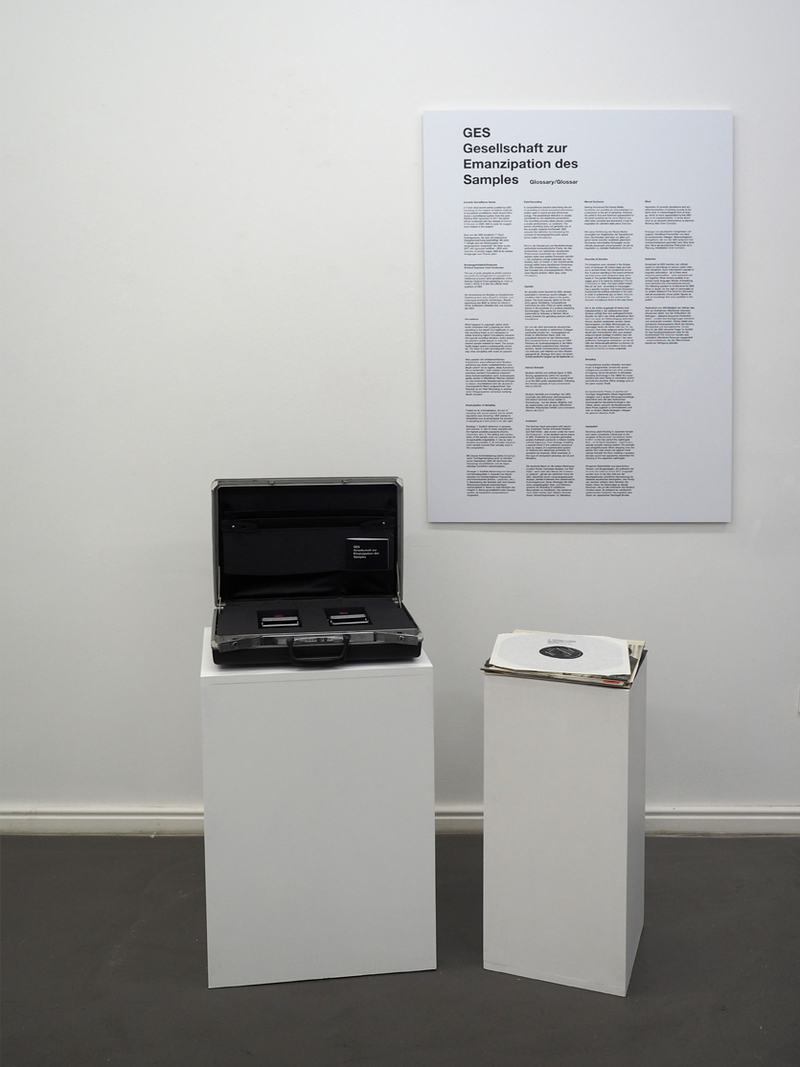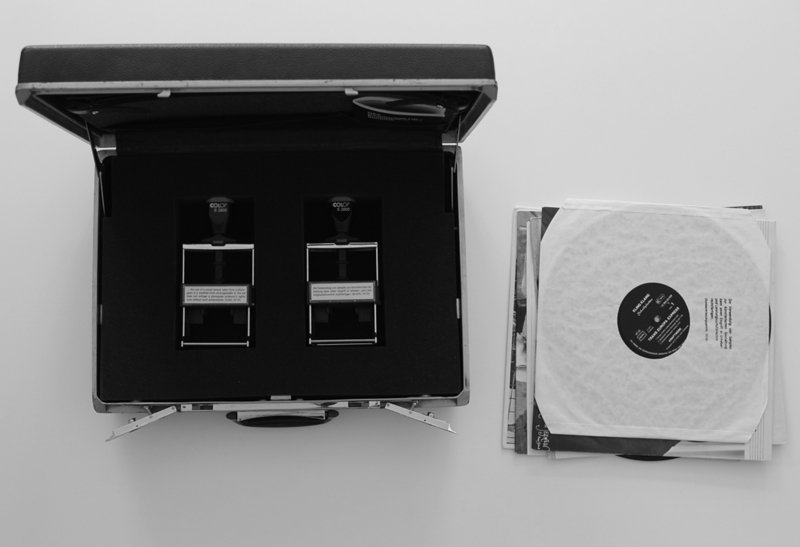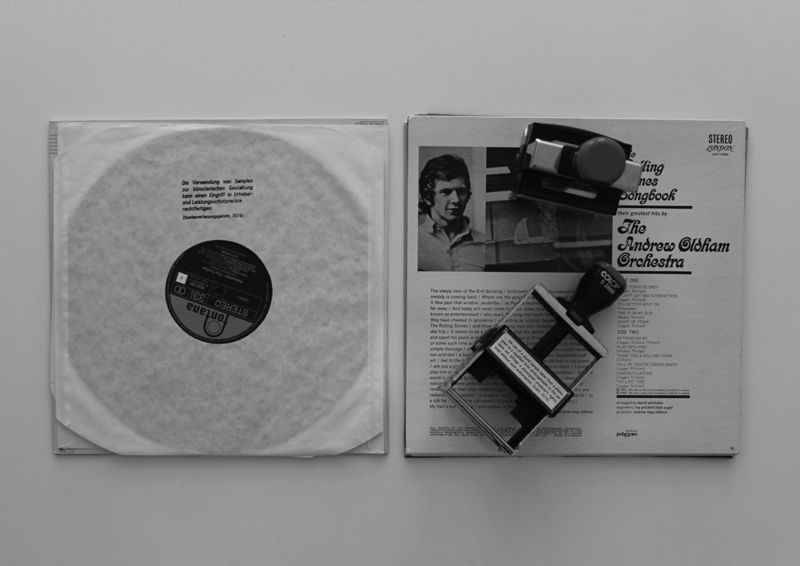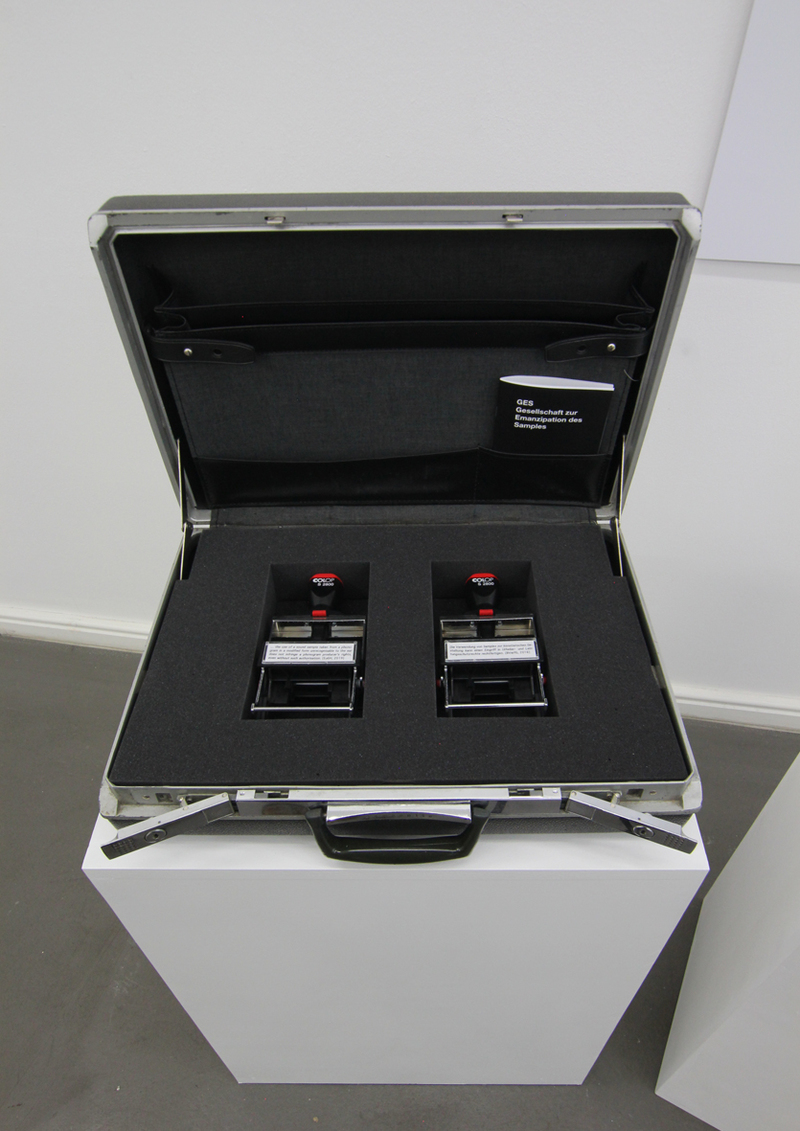GES - Gesellschaft zur Emanzipation des Samples:
Arbeitsmappe GES
GES - Gesellschaft zur Emanzipation des Samples:
Arbeitsmappe GES
Arbeitsmappe GES (workbook GES), (1 Samsonite briefcase, 2 stamps, GES Glossary booklet/poster print, and various vinyl records whose contents were subject of a copyright dispute), 2019.
In 2009 Jan Jelinek founded the Society for the Emancipation of Sampling (GES). Number of members: one person. Purpose: Fuelled by its criminalization, the act of sampling existing recordings forfeited some of its artistic prestige. GES wishes to rehabilitate and re-emancipate the practice of sampling as a form of art in its own right.
Arbeitsmappe GES contains two rubberstamps with extracts from the legal ruling on "Metall auf Metall II" (copyright dispute, Kraftwerk v. Moses Pelham) from the BGH (2016) and ECJ (2019). The legal rulings are stamped onto the material to be sampled (LP), with a preference for albums whose copy right owners are known for aggressively defending their rights. Each collage/sample artist is invited to stamp their sample sources/sound carriers brought along on site. Stamp 1: … the use of a sound sample taken from a phonogram in a modified form unrecognisable to the ear does not infringe a phonogram producer’s rights, even without such authorisation (Court of Justice of the European Union). Stamp 2: Die Verwendung von Samples zur künstlerischen Gestaltung kann einen Eingriff in Urheber- und Leistungsschutzrechte rechtfertigen. (Bundesverfassungsgericht)

Arbeitsmappe GES and GES Glossary, Laura Mars Gallery 2019 (photo by U. Siegfriedt)
GES Gesellschaft zur Emanzipation des Samples
Active members: Helmut Schmidt, Jan Jelinek
Founded: 2009
Headquarters: Federal Court of Justice, Karlsruhe, Germany
GES Glossary
Acoustic Surveillance Series
A 7-inch vinyl record series curated by GES focussing on historical methods of acoustic surveillance. Each record introduces a surveillance system from the past. Starting with Uguisubari in 2017, the series will continue with the release of Oreccio di Dionysio in 2021. GES is open to further suggestions on this subject.
Bundesgerichtshof (German Federal Court of Justice), Karlsruhe
“The use of audio samples as artistic practice may justify the infringement of copyright and intellectual property rights.” (ruling of the German Federal Court of Justice pertaining to Metall auf Metall II, 2016). The court is also the official headquarters of GES.
Circulations
What happens to copyright claims when music from a passing car is captured in a street recording? Is it legal to use this recording freely or is it necessary to obtain licensing rights? Circulations re-enacts this recording situation: audio players are placed in public spaces, where they reproduce the desired sample material. The acoustically choreographed space is then recorded, creating a field recording in which everyday noises circulate together with seemingly incidental music.
Emancipation of Sampling
Fuelled by its criminalization, the act of sampling existing recordings forfeited some of its artistic prestige (see Sampling). GES wishes to rehabilitate and re-emancipate the practice of sampling as a form of art in its own right. Strategy: 1. Name samples and sources explicitly. 2. Choose samples that are as popular and as recognizable as possible (Beatles, Carpenters, etc.). 3. The editing and manipulation of the sample must not compromise its recognizability (negotiable). 4. Use as many samples as possible. 5. Always name more sample sources than were actually used in the composition.
Field Recording
A compositional practice widely used in sound art and ethnomusicology that involves the recording of natural acoustical phenomena. Two additional requirements are usually imposed: The recording process should take place outside a studio environment, i.e. outdoors. And the person recording does not generate any of the acoustic material him/herself. GES expands this definition by introducing the concept of choreographed public space (see Circulations).
Gambling
An acoustic event favoured by GES, already used in numerous sound collages (must take place in public). The most popular option is thimblerig, a cup and ball gambling game commonly played in the street. Compositional instruction by GES: Place an audio playback device in the proximity of a thimblerigger. Play works for orchestra (by Debussy or Mahler). Move slowly towards the gamblers with a microphone.

The briefcase contains two rubberstamps with extracts from the legal ruling on "Metall auf Metall II" (copyright dispute, Kraftwerk v. Moses Pelham) & the GES Glossary booklet.
Helmut Schmidt
Multiple identity and fictional character devised by GES. Figures variously within the semiotic system of GES as member, guest artist or public representative. Following the historical example of Subcommandante Marcos (EZLN).
Kraftwerk
The German band founded by electropop musicians Florian Schneider-Esleben and Ralf Hütter (a.k.a. Die Prozessoren) is the natural enemy of GES. Protected by computer-generated avatars, Kraftwerk operates a quote-hostile cultural hegemony. Their strategy: Install a special brand in the collective consciousness by means of a sophisticated system of quotations and references that may in turn not be quoted by anyone else. Other bands with such delusions of omnipotence: U2, Metallica.
Marcel Duchamp
As the inventor of the readymade, Duchamp may be viewed as a precursor to the art of sampling. However, the artist is appreciated above all for his sonorous qualities, as his vocal silence has often been sampled and processed. It was the inspiration for Jelinek's radio play Zwischen.
Orecchio di Dionisio
This 65-meter-deep limestone cave in the Sicilian town of Syracuse, carved out of a hillside in ancient times, has exceptional acoustics: A person standing at the cave entrance can hear every word whispered deep down inside it. The painter Michelangelo da Caravaggio gave it its name (The Ear of Dionysius) in 1608. The cave indeed resembles an ear and – according to Caravaggio – had a specific function: The tyrant Dionysius I imprisoned his political prisoners in the cave in order to spy on them. Orecchio di Dionisio will be featured in the Acoustic Surveillance Series in the near future.
Sampling
Compositional practice whereby recorded music is fragmented, turned into sound collages and transferred into different contexts of meaning. Since the advent of affordable sampling technology in the 1990s, the music industry has been trying to criminalize and/or promote the practice. Both strategies are driven by the same principle: Profit.
Uguisubari
Sound-making floorboards in Japanese temple and castle complexes, featured in the Acoustic Surveillance Series in 2017. In the Edo period, the “nightingale floor” (literal translation of uguisubari) was a popular acoustic warning system. The principle was straightforward: When someone stepped onto the boards, nails would rub against metal clamps beneath the floor, creating a tell-tale squeaky sound that was said to resemble the chirping of the Japanese nightingale.
Wind
A generator of acoustic events and an amplifier/transmitter of existing sounds. A meteorological form of energy appreciated by the GES on account of its unpredictability. A series about wind as an acoustic phenomenon is planned. Working title: Hotel Corridors.
Zwischen (Between)
Radio play by GES member Jan Jelinek based on recordings of various public interview situations. From the speech of the interviewees (all of them eloquent personalities) the pauses between coherent utterances were extracted and assembled. What we hear is an archaic body language: modes of breathing, word particles and onomatopoeic turmoil. A key question for GES: Which comes first, personal rights or artistic freedom? For Zwischen, Jelinek used only recordings by public figures that were already available to the public.

The legal rulings are stamped onto the material to be sampled (LP), with a preference for albums whose copy right owners are known for aggressively defending their rights.
deutsch:
Arbeitsmappe GES, (1 Samsonite Aktenkoffer, 2 Stempel, Heft & Plakat GES Glossar sowie diverse Vinyltonträger, deren Inhalt Gegenstand eines Urheberrechtsstreits war), 2019
2009 gründete Jan Jelinek die Gesellschaft zur Emanzipation des Samples (GES). Mitgliederanzahl: eine Person. Zielsetzung: Mit der Kriminalisierung verlor Tonträgersampling an künstlerischer Reputation. GES will die Praxis des Samplings Resozialisieren und als eigenständige Kunstform Reemanzipieren.
Arbeitsmappe GES beinhaltet zwei Stempel mit Textauszügen der Rechtsprechung "Metall auf Metall II" (Kraftwerk gegen Moses Pelham) vom BGH (2016) und EuGH (2019). Aufgabe ist es, Rechtsprechung zu multiplizieren, indem sie auf Tonträger gestempelt wird. Bevorzugt sind LPs, deren Urheber für ein aggressives Vertreten ihrer Rechtsansprüche bekannt sind. Jeder Collagen-/Samplekünstler ist eingeladen, seine mitgebrachten Samplequellen/Tonträger vor Ort ab- bzw. freizustempeln.
GES Glossar
Acoustic Surveillance Series
Eine von der GES kuratierte 7“-Vinyl-Tonträgerserie, die sich mit historischer Klangüberwachung beschäftigt. Mit jeder 7“-Single wird ein Abhörsystem der Vergangenheit vorgestellt. Die Serie wurde 2017 mit Uguisubari eröffnet - 2020 wird Orecchio di Dionisio folgen. GES ist für weitere Anregungen zum Thema offen.
Bundesgerichtshof Karlsruhe
Die Verwendung von Samples zur künstlerischen Gestaltung kann einen Eingriff in Urheber- und Leistungsschutzrechte rechtfertigen. (Rechtsprechung des BGH zu Metall auf Metall II , 2016). Außerdem offizieller Sitz und Zentrale der GES.
Circulations
Was passiert mit urheberrechtlichen Ansprüchen, wenn während einer Straßenaufnahme aus einem vorbeifahrenden Auto Musik ertönt? Ist es legitim, diese Aufnahme frei zu verwenden - oder müssen Lizenzrechte erworben werden? Circulations inszeniert diese Aufnahmesituation nach: Audioabspielgeräte werden in öffentlichen Räumen platziert um das erwünschte Samplematerial erklingen zu lassen. Anschließend wird der akustisch-choreografierte Raum aufgezeichnet. Das Resultat ist ein Field Recording, in welcher nebst Alltagsrauschen scheinbar beiläufig Musik zirkuliert.
Emancipation of Sampling
Mit dessen Kriminalisierung (siehe Sampling) verlor Tonträgersampling auch an künstlerischer Reputation. GES will die Praxis des Samplings Resozialisieren und als eigenständige Kunstform Reemanzipieren. Strategie: 1. Explizite Benennung von Samples und Samplequellen 2. Auswahl von Musiksamples mit höchstmöglicher Popularität und Erkennbarkeit (Beatles, Carpenters, etc.) 3. Bearbeitung des Samples darf nicht dessen Wiedererkennbarkeit beeinträchtigen (verhandelbar) 4. Nutze so viele Samples wie möglich 5. Nenne grundsätzlich mehr Samplequellen als tatsächlich kompositorisch eingesetzt.
Field Recording
Eine in der Klangkunst und Musikethnologie verbreitete kompositorische Praxis, die das Aufzeichnen von natürlichen akustischen Phänomenen beschreibt. Zur Definition werden meist zwei weitere Parameter bemüht: 1. Die Aufnahme erfolgt außerhalb des Tonstudios, bzw. im Freien. 2. Der Aufnehmende erzeugt selbst keine akustischen Ereignisse. Die GES erweitert die Definition, indem es das Konzept des choreographierten öffentlichen Raums einführt. Mehr dazu unter Circulations.
Glücksspiel
Ein von der GES favorisiertes akustisches Ereignis, das bereits in zahlreichen Collagen verarbeitet worden ist - vorausgesetzt es findet im öffentlichen Raum statt. Die populärste Variante ist das Hütchenspiel. Eine kompositorische Anweisung der GES: Platziere ein Audioabspielgerät in der Nähe eines öffentlich praktizierenden Hütchenspielers. Spiele Orchesterwerke (wahlweise von Debussy oder Mahler) auf dem Wiedergabegerät ab. Bewege dich dann mit einem Aufnahmemikrofon langsam auf die Spielenden zu.
Helmut Schmidt
Multiple Identität und Kunstfigur der GES. Innerhalb des GES'schen Zeichensystems tritt Helmut Schmidt immer wieder in Erscheinung - mal als dessen Mitglied, mal als Gastkünstler, mal als deren öffentlicher Vertreter. Historisches Vorbild: Subcomandante Marcos der EZLN
Kraftwerk
Die deutsche Band um die beiden Elektropopmusiker Florian Schneider-Esleben und Ralf Hütter - auch unter dem Namen Die Prozessoren bekannt - gilt als der natürliche Feind der GES. Geschützt durch computergesteuerte Avatare, betreibt Kraftwerk eine zitatfeindliche Kulturhegemonie. Deren Strategie: Mit Hilfe eines ausgeklügelten Zitat- und Referenzsystems ein Branding im kollektiven Bewusstsein zu installieren, das wiederum nicht zitiert werden darf. Weitere Vertreter dieser Allmachtsphantasie: U2, Metallica
Marcel Duchamp
Mit seiner Einführung des Ready Mades womöglich ein Wegbereiter der Samplekunstform. Der Künstler wird aber vor allem aufgrund seiner sonoren Qualitäten geschätzt: Duchamps stimmhaftes Schweigen wurde oftmals gesampelt und prozessiert. Es gilt als Inspiration zu Jelineks Radiostück Zwischen.

Arbeitsmappe GES, Laura Mars Gallery 2019
Orecchio di Dionisio
Die in der Antike angelegte 65 Meter tiefe Kalksteinhöhle in der sizilianischen Stadt Syrakus verfügt über eine außergewöhnliche Akustik: Ein tief in der Höhle geflüstertes Wort kann von einer am Höhleneingang stehenden Person deutlich verstanden werden. Deren Namensgeber und Maler Michelangelo da Caravaggio taufte die Höhle 1608 Das Ohr des Dionysius. Zum einen aufgrund seiner Form (Sie ähnelt dem menschlichen Ohr), zum anderen aufgrund seiner einstigen Funktion: Laut Caravaggio ließ der Tyrann Dionysius I. hier seine politischen Gefangenen einkerken, um sie mit Hilfe der Höhlenakustik abhören zu können. Im Rahmen der Acoustic Surveillance Series wird Orecchio die Dionisio in Kürze vorgestellt.
Sampling
Kompositorische Praxis, in welcher auf Tonträger festgehaltene Musik fragmentiert, collagiert und in andere Sinnzusammenhänge übermittelt wird. Mit dem Aufkommen erschwinglicher Sampletechnologie in den 1990er Jahren versucht die Musikindustrie diese Praxis zugleich zu kriminalisieren und/oder zu fördern. Beide Strategien obliegen der gleichen Maxime: Profit.
Uguisubari
Klingende Dielenböden aus japanischen Tempel- und Burganalagen, die anlässlich der Acoustic Surveillance Series 2017 vorgestellt worden sind. In der Edo Zeit war der Nachtigallboden (wörtliche Übersetzung) ein beliebtes akustisches Warnsystem. Das Prinzip war denkbar einfach: Beim Betreten der Dielen rieben die Dielennägel an Metallklammern, die auf der Unterseite des Bodens montiert waren. So entstand ein verräterisch-quietschendes Geräusch, das angeblich dem Zirpen der Japanischen Nachtigall ähnelte.
Wind
Erzeuger von akustischen Ereignissen und zugleich Verstärker/Transmitter von bereits existierenden Klängen. Meteorologische Energieform, die von der GES aufgrund ihrer Unberechenbarkeit geschätzt wird. Eine Serie über den Wind als akustisches Phänomen ist in Planung, Arbeitstitel: Hotel Corridors
Zwischen
Radiostück von GES-Mitglied Jan Jelinek, das sich auf Aufnahmen öffentlicher Interviewsituationen stützt. Aus der Artikulation der Befragten - allesamt eloquente Persönlichkeiten - wurden ihre Verzögerungen extrahiert und aneinander montiert. Hörbar bleibt eine archaische Körpersprache: Modi des Atmens, Wortpartikel und lautmalerischer Tumult. Eine für die GES relevante Frage: Im Zweifel für das Persönlichkeitsrecht oder für die Kunstfreiheit? Für Zwischen wurden ausschließlich öffentliche Personen ausgewählt - sowie Aufnahmen, die der Öffentlichkeit bereits zur Verfügung standen.